Add a Google Cloud Connection to a Cloud Router
The process for adding a Google connection depends on whether you are using a Google Cloud access key:
- Provision with a key - From the PacketFabric portal you can provision the connection, create the VLAN attachment, and automatically accept it from the Google side.
- Provision without a key - You must create the VLAN attachment in the Google Cloud console and then create the PacketFabric Cloud Router connection in the PacketFabric portal. Then return to the Google Cloud console to accept the connection.
Provision using a Google Cloud access key
Prerequisites
- A VPC created through your Google Cloud account. For more information, see Google Cloud - Using VPC networks.
- A PacketFabric Cloud Router. For more information, see Create a Cloud Router.
- A Google service account and key. For more information, see Google Cloud Access Keys.
- Enable the Compute Engine API (ensure you are in the correct project).
Create the Cloud Router connection and the VLAN attachment
Log in to the PacketFabric portal and select Cloud Routers on the left.
Expand the Cloud Router you are using and click Connect.
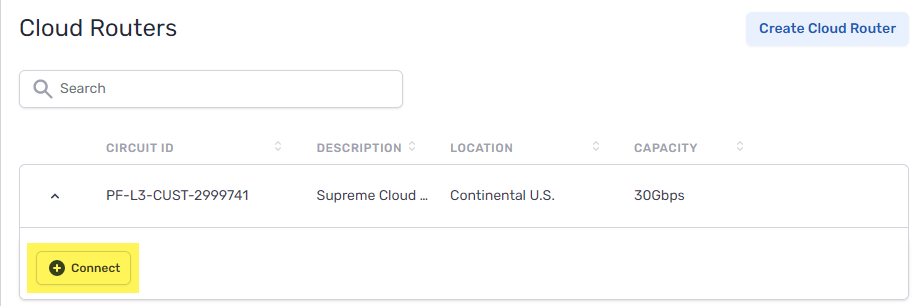
Select Google Cloud.
Configure
- Enable Network Address Translation
- Select this option if you want to be able to use NAT for the connection. This ensures the connection will provision on a device that supports NAT.
- Source NAT – Translate the source IP address. For example, you can translate a pool of private IP addresses to a public IP address in order to reach an external resource that only accepts public IPs.
- Use a public IP for SNAT pool prefix – Select this option to obtain a public IP address to use with your SNAT configuration.
- Destination NAT – Translate the destination IP address. For example, if you need to translate a public IP address to a private IP addresses in your network. This may be necessary if you plan to make the connection exportable via Quick Connect.
- OnRamp
- The Google Cloud on-ramp location. This cannot be changed after it is provisioned.
- Speed
- The speed you want for your connection.
- Description
- Enter a brief description for the connection.
- Provision Google Cloud side of the connection
- Select this option.
- Region
- Select a Google Cloud region. This will determine which Google Cloud Routers are available for selection.
- We recommend that you select the same region as the on-ramp you selected above.
- Project ID
- (Optional)
- Enter the ID associated with the Google Cloud project. The credentials you are using must have the necessary permissions for the project.
- Leave this field blank to select the project associated with the Google Cloud credentials.
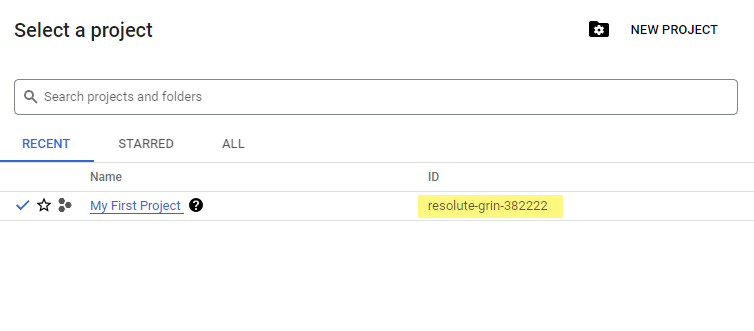
- VLAN attachment
- Enter a name for the VLAN attachment.
- Edge availability domain
- The availability domain for the VLAN attachments.
- If you are provisioning redundant connections in the same location, select a different availability domain for each.
- Google Cloud Router
- Here you can select an existing Cloud Router or create a new one. Only Cloud Routers located in the region above appear in the drop-down list.
- Cloud Routers are tied to a single region and VPC, so in many cases you will likely be creating a new Cloud Router.
- However, if you are creating a redundant VLAN attachment, you will want to select the same Cloud Router as the primary VLAN attachment but a different edge availability domain.
- Note that each region can support up to 5 Cloud Routers.
- Network VPC
- If you selected an existing Cloud Router, this field is pre-populated and cannot be changed.
- If you created a new Cloud Router, select an available VPC.
- Google BGP ASN
- The Google Cloud Router ASN should be 16550.
- The exception is if you are routing traffic between Google Cloud connections on the same Cloud Router. In which case, you can edit the ASN to 64512-65534 or 4200000000-4294967294. For more information, see the Google Cloud Router ASN workaround.
- BGP Customer Router’s ASN
- The ASN to use with your router when establishing the BGP session.
- This can be public or private from 1 to 4294967294.
Advanced Google Cloud settings
- VLAN attachment MTU - Select the MTU for the VLAN attachment.
- Keepalive interval - This is the interval in seconds between BGP keepalive messages that are sent to the peer. If set, this value must be between 20 and 60. The default is 20.
- BGP authentication key - Optionally, supply an authentication key to use MD5 authentication with the BGP session. Limited to 80 characters.
- Allowed prefixes to cloud
- This is a list of addresses that you want to allow into your Google Cloud environment from other connections within the Cloud Router. You can add up to 1000 prefixes.
- Row
- Field
- Description
- Row
- Prefix/Mask
- Enter an allowed IP address range in CIDR format.
- Row
-
Match type
-
Whether the allowed prefix must match exactly or whether it uses an
orlongerfilter.For example,
172.16.2.0/24or longer would also allow172.16.2.128/25.
-
- Row
-
AS prepend
-
Number of additional times to add the ASN to the BGP path, resulting in a higher path length. Allowed values are integers from 0 to 5.
Routes with higher path length (a higher ASN prepend value) have a lower priority.
-
- Row
-
MED
-
The multi-exit discriminator (MED) value. Allowed values are integers from 0 to 4294967295.
When the same route is advertised in multiple locations, those with a lower MED are preferred by the peer AS.
-
- Allowed prefixes from cloud
- This is a list of addresses from within your Google Cloud environment that you want to advertise to other connections on the Cloud Router. You can add up to 1000 prefixes.
- By default, this is populated with the subnets in the VPC you selected above. However, you can add or modify the subnets. If no prefixes are provided, the advertisement mode will be set to Default.
- Row
- Field
- Description
- Row
- Prefix/Mask
- Enter an allowed IP address range in CIDR format.
- Row
- Match type
- Allow or disallow longer prefixes for this row (see the description above).
- Row
- Local preference
- When the same route is received in multiple locations, those with a higher local preference value are preferred by the PacketFabric Cloud Router. Allowed values are integers from 0 to 4294967295.
NAT settings
These settings only appear if you selected a NAT-capable on-ramp above.
Select Configure later to complete NAT setup after the connection provisions.
If you selected Use a public IP for SNAT pool prefix, you can leave NAT Pool Prefixes blank.
Under the billing section on the right, select a term and the appropriate billing account to use. You can also optionally specify a PO number to associate with the service. The PO number will be included on your monthly invoice.
Click Place order.
Provision without using a Google Cloud access key
Process overview
The basic steps to adding a Google connection to a PacketFabric Cloud Router are as follows:
- From the Google side: Create a Google Cloud Router with ASN 16550.
- From the Google side: Create a VLAN attachment.
- From the PacketFabric side: Create a Cloud Router connection.
- From the Google side: Accept the connection.
- From both sides: Configure BGP.
Create a VLAN attachment in Google Cloud Console
-
Click the menu in the upper right to open the product list.

-
Scroll down to Networking and select Hybrid Connectivity > Interconnect.
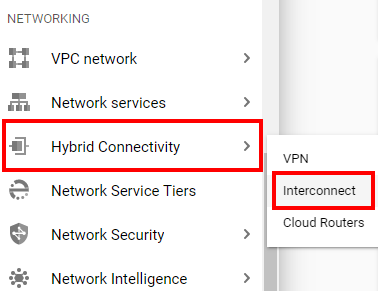
-
If you already have previous VLAN attachments, click Add VLAN Attachment. Otherwise, click Get Started.
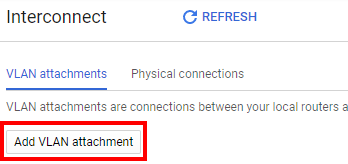
-
Select Partner Interconnect and then click Continue.
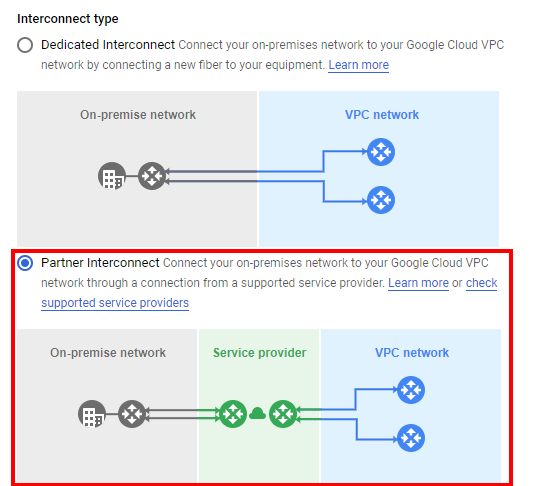
-
Click I already have a service provider.
-
Complete the following fields:
-
Header row
- Field
- Description
-
r1
- Redundancy
- Select whether you are creating a single attachment, redundant attachments, or adding a redundant attachment.
-
r1
-
Network
-
Select the VPC to which you will be connecting.
For more information about creating VPCs, see Google Cloud - Using VPC networks.
-
-
r1
-
Region
-
Select the region in which you want to connect. PacketFabric on-ramps can serve all of Google’s U.S. regions and northamerica-northeast-1 (Montreal).
Internationally, all of Google’s European regions are accessible from our London on-ramp.
Our Sydney on-ramp serves Google’s australia-southeast-1 regions.
-
-
r1
-
Cloud Router
-
Note - This refers to Google’s Cloud Router product, which is not related to the PacketFabric Cloud Router.
If you have already configured a Cloud Router for the selected region, you can select it. If you are creating redundant VLAN attachments, each attachment requires its own Cloud Router.
Otherwise, create a new cloud router.
IMPORTANT: You must select or create a Cloud Router with its Google ASN set to 16550. This is a Google requirement for all Partner Interconnects.
-
-
r1
- VLAN attachment name
- Enter a name for this VLAN attachment.
-
r1
- Description
- Optionally, enter a description for this VLAN attachment.
-
r1
- Maximum transmission unit (MTU)
- Select an MTU for the VLAN attachment. PacketFabric supports up to 9000 bytes MTU.
-
-
Click Create.
-
Copy the pairing key. You need this when creating your hosted connection from the PacketFabric portal.
-
Leave the Enable option unselected.
-
Click OK.
Create a PacketFabric Cloud Router connection
Log in to the PacketFabric portal and select Cloud Routers on the left.
Expand the Cloud Router you are using and click Connect.

Select Google Cloud.
Configure
- Enable Network Address Translation
- Select this option if you want to be able to use NAT for the connection. This ensures the connection will provision on a device that supports NAT.
- Source NAT – Translate the source IP address. For example, you can translate a pool of private IP addresses to a public IP address in order to reach an external resource that only accepts public IPs.
- Use a public IP for SNAT pool prefix – Select this option to obtain a public IP address to use with your SNAT configuration.
- Destination NAT – Translate the destination IP address. For example, if you need to translate a public IP address to a private IP addresses in your network. This may be necessary if you plan to make the connection exportable via Quick Connect.
- OnRamp
- This is the Google on-ramp location you would like to use. This cannot be changed after it is provisioned.
- Speed
- This is the speed/capacity you are setting for your VLAN attachment.
-
NOTE: The capacity you select determines the hourly price Google charges you for your VLAN attachment. See Google’s Partner Interconnect Pricing for more information.
- Description
- Enter a description for the connection.
- Provision Google Cloud side of the connection
- Leave this unselected
- Google Pairing Key
- Enter your GCP pairing key. This is generated when you create a VLAN attachment.
- VLAN attachment name
- Enter the exact VLAN attachment name you provided to Google.
Under the billing section on the right, select a term and the appropriate billing account to use. You can also optionally specify a PO number to associate with the service. The PO number will be included on your monthly invoice.
Click Place order.
Activate the connection in Google Cloud Console
-
Once provisioning is complete on the PacketFabric side, return to the Google Cloud Console.
-
Refresh the page. Note that the VLAN attachment status is now Activation needed.
 NOTE: If you do not see the Activation needed status, wait a a few minutes and then refresh the page again.
NOTE: If you do not see the Activation needed status, wait a a few minutes and then refresh the page again. -
Click Activate.
-
Click Accept.
This might take a few minutes to process.
Next steps
Configure the BGP session for this connection.